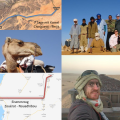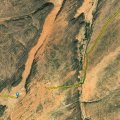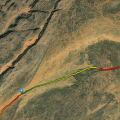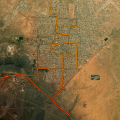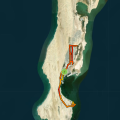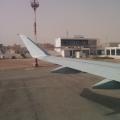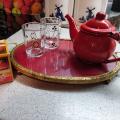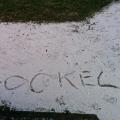Back to Mauritania
It has been a while since I last posted anything in this blog. Given the five year anniversary of the abrupt end of our adventure through western Africa, I’d like to take you along for a trip down memory lane. Even though I left the previous series of posts open ended, I’d like to jump ahead two years to December 2019, when I went back to Mauretania. I really wanted to revisit this amazing country and follow my fathers footsteps who came back with great stories from his trips in the desert. In particular, I was looking forward to finally take a ride on the iron ore train that we tried to get on together back in 2018.
Part I: Méharée
The first part of the trip was organised by indogo-reisen from Switzerland and started on December 22nd in the capital Nouakchott. Early the next morning after everyone from our group arrived, we drove north-east to Chinguetti where we would visit one of the ancient libraries and meet the chameliers who would guide us through the sandy dunes north of Erg Amatlich.
Our group of five Swiss and me was lead by Sidat and accompanied by four chamelies (who take care of the camels) and a cook and his helping hand. With such a great support team, a trip through the harsh environment of the desert is actually not all too bad! In total we covered 95.6km in seven days to Terjit. Although one would think the desert is a flat place (or at least I did), we had a cumulative elevation gain of about 1100m even though we went around all the dunes. Climbing them head on is actually almost impossible as one would sink into the sand (as on the flat, actually) and slip down again.
Everytime I think back to this trip, one of the first things I remember is this relaxing state of tranquility from the moment I got there. Apart from the occasional flapping of a loose cord of the backpack in the wind, there is absolute silence. Walking through the hot in the relentlessly blazing sun with no shade as far as you can see becomes meditative. In particular when walking behind a camel, weirdly enough. These animals are made for this environment and even though at first they seem clumsy in the way they move, once you watch how they carefully take every step and their big flat feet (or hoofs?) softly hit the sand and seem to melt into the ground, all thoughts of anyting really are taken away by the winds into the endless desert. Although the landscape seems boring in photos (I have to admit, sorting through the heap of dune photos, of which I have plenty), you start to discover the smaller details and come to appreciate the beatiful different shades of the sand. Unfortunately, this does not at all translate well into photos, but I tried to compile some different patterns from the first few days in the dunes of Erg Ouarane.
The guides always found a few small trees where we would have some shade and rest during the heat of the day. Some of the younger camels also got a snack every now and then if our camp was in an area where they couldn’t find enough during the night. Simple and ingenious: Make a hole, put a blanket on top, and you get an in-promptu feeding dish.
Speaking of camps, here are a few impressions. Even though it looks like complete chaos, the way all the bags are scattered across the area actually follows a strict plan! All the stuff we carried with us is balanced in size and shape for each camel and laid out in such a way, that they don’t have to guess where things go the next morning. Once the camels are unloaded, they immediately stroll of and search for food nearby while we humans set up camp and the cook starts cooking. As darkness sets in and the last branches of the small bonfire are gone, everyone wanders off to their sleeping mat and settles in for the night.
The days went by very quickly. After passing an oasis half-way, the landscape started to change as we got closer to Mont Zarga. With harder ground and rocks it also became easier to walk.
Although I rarely got to see any wildlife, I found it quite fascinating to at least see tracks everywhere. This also includes beautiful patterns left by all kinds of bugs. Almost every morning I would wake up to find there was yet another curious visitor during the night who left tracks in the sand around my sleeping bag.
Arriving at the Oasis of Terjit was almost surreal. Suddenly there were “many” other tourists, loads of water in small ponds, pools and streams, and an overall completely different ambience as if someone flipped a switch as we descended into the valley. From there, on December 29th, I parted the group to continue on my own.
Part II: The Train
I had it pre-arranged to have someone drive me to Atar, the closest town on the main road from Nouakchott to the mines in Zouérat. As night was approaching and I probably wasn’t going to find a bus further north anyway, I spent the night there.
The next morning I went to the market place to find a bus and prepare for train. I didn’t bring anything along before because it seemed a little unfair for the camels to carry stuff they didn’t need to carry. So I checked loads of stores in search for a thick old blanket (which is quite tricky with no French or Arabic skills and everyone trying to sell me a very fancy new blanket) and some cheap trousers—both of which will very likely be ruined the following day anway. I got what I needed and was off to Zouérat in a small bus with loads of people inside and goods on top. My plan was to find a place to stay for the night, so I could spend New Years eve on the train. Unfortunately, after walking to every (supposed) accomodation I could find on maps and in guides, the night was approaching and I was without a place to sleep.
Although I was disappointed at first, this suddenly felt like an even more fun adventure, so I walked towards the tracks where, from what I gathered, the train would slow down for people to jump on. After I bought loads of water and some snacks to be ready any time. Heople got curious what a white guy like me is doing lurking around the tracks at that time of day.
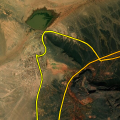
As it turns out, the train wouldn’t pass there anytime soon, but from the other side of the mines in Fderik. Furthermore, after a friendly man called his friend from the train company when the next train would leave, it turned out it actually just did. But there was another stop planned and before I knew it, they put me in a taxi which got me to that stop rather quickly. The driver was constantly at the phone, and, from what I gathered, he too knew someone from the train company and told him to wait. Though a little zig-zag and checkpoints we arrived at the end of the train and people all around scrambled to get me into the second-to-last waggon with flour, a few goats and two men.
This really wasn’t what I wanted! I was looking forward to being alone on top of the ore somewhere in the middle of the train. Now, I had to stand up on a box just to look outside the cart and had a passenger carriage in front and behind, so I couldn’t even see the entire train in front of me, which can be up to 3km long. Although I was sad that, yet again, things didn’t turn out as I hoped, I was still very excited and couldn’t get enough. As night was approaching, the train stopped. This is quite normal, so that people can get off or trade along the way. After a few minutes I thought this must be one of those stops and jumped off (completely ripping my new colourful trousers) agains the protest of the others in my cart.
I didn’t even make it past the next carriage as the train slowly started to move. Loaded with my backpack and a bunch of small water bottles and my blanket in my arms I started to run as fast as I could. Even though it looks like heavy freight trains like this accelerate very slowly, this is actually feels rather fast in this situation, where I was in the middle of the desert with nothing around but the train tracks and night appoaching. Would I even be able to get the next train (there are usually two a day) to stop for me at this point? Luckily, I was close to one of the two closed carriages that are attached to the end of the train so that people can ride along. They probably already noticed me and opened a door for me and helped me jump on the moving train with no time to spare.
This suddenly got me in a completely different situation. There I was, crammed between a group of young men, who were most curious of why the hell I was even on this train. Yet again, I was reminded that learning at least some French beforehand would probably have been a good idea. Although it was probably a very authentic experienc, it felt quite stressful for me, as I also wanted to communicate, but couldn’t. Addinionally, now I saw even less from the landscape (nothing actually), so the thought of spending the next 20-24 hours like this was daunting. Just an hour or so later, the train stopped again.
This was my chance to get to the front! So I just jumped off and ran until I got out of breath, which was nicely timed by the train beginning to move again. This time I got what I wanted: A cart for myself, in the middle of the train (more or less at least), on top of the iron ore! In the cart just behind me was a man with his son, who were on their way back from a trade run to bring fruits from the coast to the mining town (you can see the empty crates on one of the photos). They cooking their dinner and traded some of my water for tea, which was really nice. Eventually, they invited me over to eat with them.
The next morning, as they were picket up, I helped them load their crates into the van and they took me into town, so I wouldn’t have to walk the 3km or so from where the train stopped.
Having been here just two years before, I already knew a great place to stay (Baie du Levrier). This is also the place where my dad went to after he went on the train, so I also knew the owner afraid of taking in dirty freight hoppers. After a refreshing shower, I was ready to enjoy the rest of the day—my 30th birthday, actually.
Part III: Nouadhibou
I spent my days in Nouadhibou walking around and discovering the different sides of the town: the market, the coast with loads of traditional fishermen, a local football game, as well as the industrial areas (why not). I also found an internet café where I sorted through some of photos to design my postcard and a copy show with the thickest paper to actually produce postcards. This is actually a really fun thing I like to do when I’m away for longer. In this way, you get a post card with stuff you’ve actually seen and in search for places that can print them for you, you get to discover more of the side-alleys.
I spent one day walking all the way to Cansado, the port and final desination of the iron ore train. After walking for a few hours along a road with only sand and ore dust, it is extremly irritating to see a small spot of lush green grass with a cat playing around. I promise, I didn’t slip this picture in from anywhere else.
Unfortunately, the actual transshipping happens even further south the peninsula and everything is locked off, so I only got to see some of the wrecked carts and apparently a German port project.
The two days in Nouadhibou already came to an end, so I had to pack my things…
… and make my way …
… to the airport.
After a short flight back to Nouakchott, where I spent the night at the airport, I was off to Berlin.
I brought some tea (and an iconic teapot + glasses, which they have everywhere there) to always remind me of this really great trip.
Most of all, it was unforgettable to experience the stories my dad came home with from his trip in the area and in this way actively carry on this memory.
